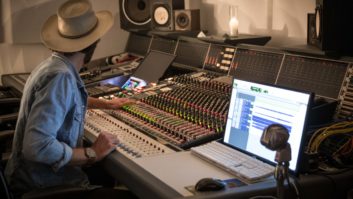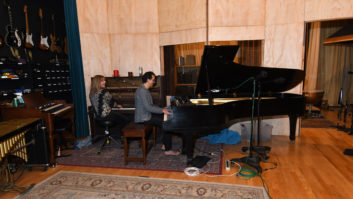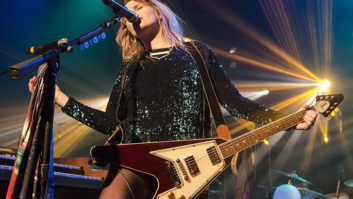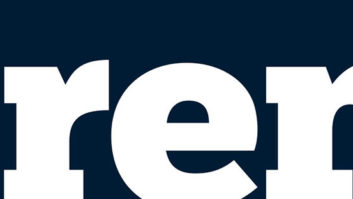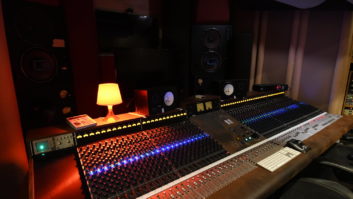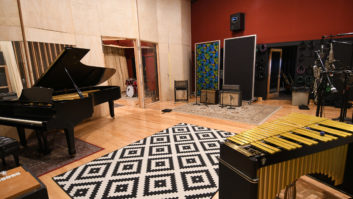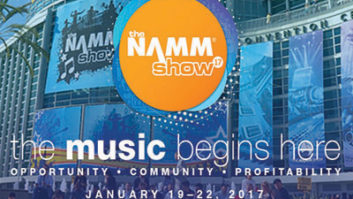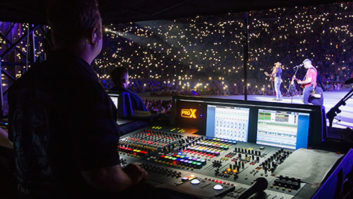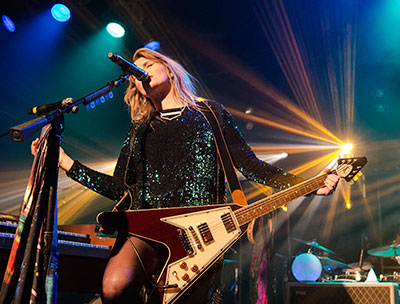
This past year has proved a period of transition for Grace Potter. The singer-songwriter has been touring behind her first solo album, Midnight, and she has a new band. And, as it turns out, Potter’s sound team just made a transition as well, to the DiGiCo SD10.
Mix caught the show at Washington, D.C.’s fabled 9:30 Club, where Potter and company will return on June 22-23.
Steppin’ Up
Sam Leonard, Potter’s front-of-house engineer, said that he “enjoyed working on the previous board,” but the early-tour switch to the DiGiCo came down to channel count. “[The old] board could only handle 48 channels,” Leonard said, “and there came a point in the tour that we needed more, to accommodate a choir, for instance. So, we went up to 64.”
That change also happened because there’s only so much room for equipment in the band’s two trailers. “We haven’t made the jump to a truck yet,” Leonard said, “so we try to provide maximum impact with the space and the budget. It was little difficult to make the jump but the DiGiCo board is laid out logically, with the touchscreen and all of its functions, and user master controls to the right of the screen. We had a rep give us a tutorial.”
In the end, it’s about the sound. And Leonard said the SD10 “is far superior, even without plug-ins.
“For instance, it has 16 assignable dynamic EQs, and that’s allowed me, for the first time, to shape Grace’s voice with attack, release and ratio parameters applied to each band of the four parametric EQs,” he explains. “She uses a Telefunken M80, which is kind of bright, and the dynamic EQ really helps smooth it. The onboard effects of the desk are much better, too, with lifelike reverbs and fun delays. Experimenting with the 10-tap delay has inspired a whole new creative element that is now featured in the show.”
A twist to the show was that it was recorded for Live at 9:30, so Leonard gave the PBS crew the soundboard feed. They can “work off the edit,” he said. “We used some ambient and audience mics that can be mixed in.”
Monitors ‘du Jour’
Also loving the increased output is Niles Anderson, Potter’s production manager/monitor engineer. “Being able to mix the show at 96k is a game-changer,” Anderson says. “After mixing on consoles at 48k for the past couple of years, your ears get trained to that; but after you start using the 96k, you appreciate the nuances.

FOH engineer Sam Leonard (left) and monitor engineer Niles Anderson at D.C.’s 9:30 Club. Photo: Mark R. Smith.
When the tour does fly dates and can’t get the SD10 (from SES, of Winston-Salem, N.C.), they typically pick up Avid Profiles for front and back of house. So far, however, the tour isn’t traveling with a particular monitor package. “Its monitor and public address du jour, depending on the venue,” Anderson says.
At the 9:30 Club, overhead mics were Shure KSM32s, with some SM81s used on hi-hats and percussion overhead. Potter’s crew uses a smorgasbord of mics, too, but has upped the ante in recent months with Telefunken M80s for all vocals (a wireless version for Potter). Shure products for the speaker cabinets and the drums—the old standard Beta 91 for the kick-in and Beta 52 kick-out—are also in the mix.
“We have 60 input mics onstage,” Anderson explains, “and the whole band is using in-ear monitors,” from Ultimate Ears and JH Audio. “I don’t have the entire band”—which Potter has dubbed The Magical Midnight Road Show—“on one model, because it’s only been together since last June,” he says.
At the Club
As for the venue, the 1,200-capacity 9:30 Club (which was once Duke Ellington’s, later WUST-AM’s studio) recently won Pollstar’s Nightclub of the Year award for the 11th time.
Interestingly, one of the most successful clubs in the country had a plaster ceiling during the WUST days. But when co-owners Seth Hurwitz and Rich Heineke bought the building in the mid-’90s, they wanted the best sound possible.
“The Walters-Stoyrk Design Group came in and helped with the elements,” says Shawn “Gus” Vitale, the club’s longtime lead sound engineer. “[WSDG] suggested the asymmetrical wall and ceiling panels, and built a wall in front of the [upstairs] VIP section.” The stage is movable, which was the idea of Chad Houseknecht, a former club employee.

Shawn “Gus” Vitale, lead engineer at 9:30 Club. Photo: Courtesy of 9:30 Club.
The most recent addition, about a year ago, was a DiGiCo SD8 desk with the Waves Server package. A few years earlier, the club installed d&b audiotechnik monitors, and a few years before that a d&b J Series P.A.
“And that’s always the question,” Vitale says. “Will the equipment still be viable in 10 years? We’ve spent money on advancements in sound and light technology since that’s part of doing business. It’s an ongoing process.”
For Potter and company, doing business at the 9:30 Club is also an ongoing process: She’s gigged there 14 times (the first 13 with the Nocturnals).“[Her crew is] stable and includes some of the best people in the industry to work with. That says something about the artist,” says Vitale, “and I love getting geeked out with Sam, Niles and their crew.”
Coming Soon to PBS
A concept long discussed, but never attempted, Live at 9:30 will be the first TV show to be produced from the venue; it took a creative approach from an independent producer and public television to finally make it happen.
The plan is to “present four to five bands per episode, with each performing two or three songs,” says PBS Executive Producer Michael Holstein. “Grace was so good that it’s going to be hard to cut it down to three; some will make TV, a couple online only and others will be dropped. We cater to the bands and Grace was really cool to work with.”
Holstein said that up to 15 cameras will be used per show, “including five handheld, five mounted, five GoPros and PBS’s signature cable-cam. We’ll connect to the soundboard with a Zoom H6N, and pick up ambient sounds of the club with a backup analog Zoom R16. Also on hand were Rode NTG3 shotgun mics, with Sennheiser laveliers with one boom mic.
